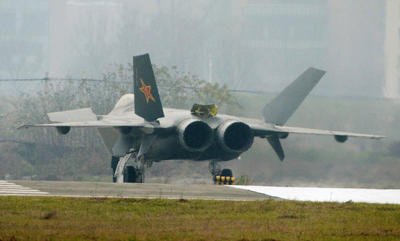Further spice was added by indications that the military may have decided to allow this sliver of transparency, and to make it coincide with Gates’ visit, without telling the political leadership. The technologies that make an aircraft stealthy rank alongside nuclear warhead design and very quiet submarines as the capabilities that the US prizes the most and has endeavoured to protect very carefully. In that sense, unveiling a stealth fighter sent a similar message to shooting down a satellite or demonstrating a kinetic kill ballistic missile defence capability; namely, that China intends to unravel the US-led political/security arrangements in East Asia.
This is good politics in contemporary China it seems, subject to finding a smart balance between this message and the posture of ‘peaceful development’ (and it would seem that the elite are no longer always of one mind as to where this balance should be struck).
Whatever the case, we will have to get used to events like this.
China’s military spending has been growing in real terms at about 10 per cent a year for 20 years. While this is not a frenzied armament program, 10 per cent real growth every year is a rich diet for any organisation. US military spending has grown that quickly only rarely, and high rates of growth have never been sustained for two decades. The People’s Liberation Army is generally doing its bit to support the image of harmony that the political leadership is striving to project but, out of the limelight, it is working very energetically indeed. And it has a lot of work to do.
China basically missed the Industrial Revolution. A dysfunctional Qing dynasty in the later decades of the 19th century, a civil war plus a Japanese invasion through 1949 followed by 30 years of doctrinaire socialism offered little scope to catch up. The Chinese leadership made some early choices about capabilities they deemed indispensable (nuclear weapons, ballistic missiles, space launch vehicles) even though they were way beyond the country’s general skill level (and therefore disproportionately costly to acquire).
Generally speaking, however, China’s technological and industrial base at the beginning of the ‘reform and open up’ era was fairly low. By all accounts, China has scoured, and is, scouring the world to acquire by whatever means necessary the technologies it needs to be competitive. In this sense the yardstick is the United States.
In the military sphere, even though it is advancing across a broad front, there is much that is still out of China’s reach. The pundits who instantly concluded that China’s new stealth fighter was a match for America’s third generation aircraft of this type, the F-22 Raptor, and superior to the F-35 that the Royal Australian Air Force will acquire in a few years, were making heroic judgements… China’s plane will take something like a decade to come into operational service, and its actual performance parameters, including the effectiveness of its stealth qualities, will remain a mystery for at least as long. China’s most recent indigenous combat aircraft, the J-10, is generally deemed to equate with early model US F-16s from around 1980. Short of stealing and reverse-engineering an actual F-22, it seems highly improbable that China will leap to the cutting edge of stealth technology in a single bound (although it is rumoured that China got hold of a significant piece of a F-117 — America’s first stealth fighter — lost over Serbia in the mid-1990s). If the US concludes that the J-20 represents a surprising leap in China’s capabilities look out for a congressional inquiry into where and how China acquired the technology!
Ron Huisken is a senior fellow in the Strategic and Defence Studies Centre at the Australian National University in Canberra.


“the J-10, is generally deemed to equate with early model US F-16s from around 1980” in more ways than according to the Chosun Ilbo, http://english.chosun.com/site/data/html_dir/2011/02/01/2011020100897.html, which has reported on CCTV lifting J10 flights from the movie Top Gun!!!
From the piece,the author seems is leaning toward the conclusion that J-22 is just another Chinese ‘pretender’, and the technology China has is the result of relentless spying work targetted on U.S. But some points need to be raised here to remind the readers: 1. what China’s doing now is just like what U.S. and Soviet Union had been doing in the period of 50s to late 80s, when there were numerous unexpectedly fast improvement and progress made by countless relatively young and energetic groups of engineers and scientists. So there is no surprise here at all.Second,it’s been claimed by some important DOD members that the technology of J-20 is not anything the Chinese can just spy and acquire from F-117,or any sort of American equivelents. I can sense sour grapes here in the Western press and from this article.
The problems with F-22 and F-35 are very obvious indeed, even to many outsiders, And the Americans know it and indeed are very nervous about it.